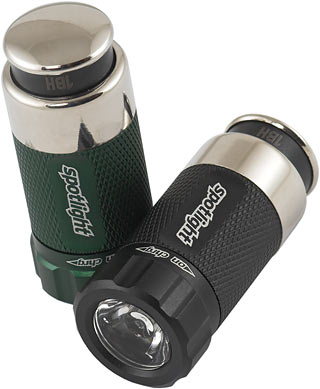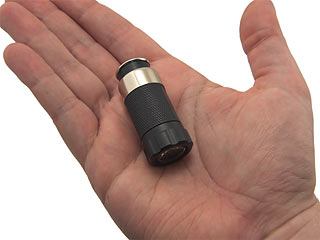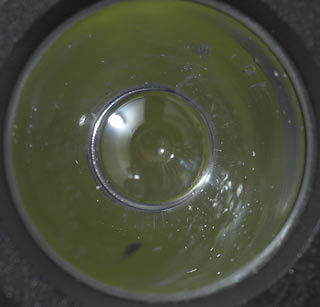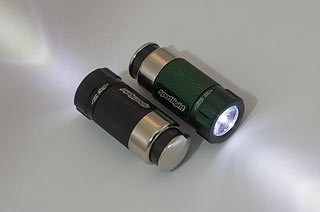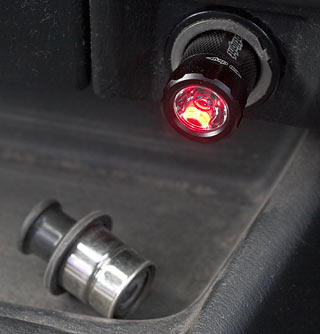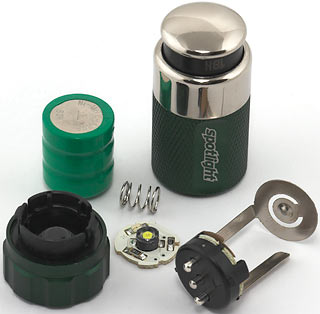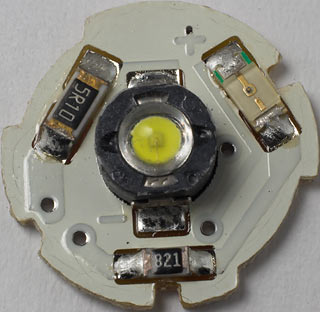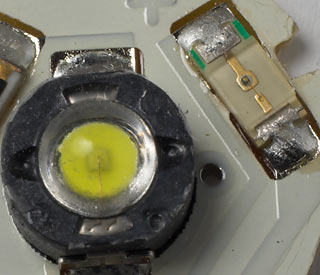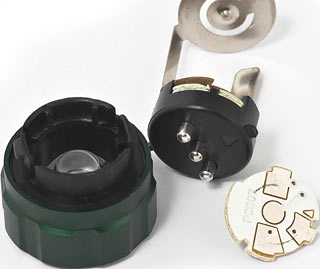
Weiguo Solutions Spotlight
Review date: 29 March 2008 Last modified 03-Dec-2011.
A little rechargeable flashlight that lives in your car cigarette lighter socket is an obvious sort of product. Dozens of the things have been made over the years, ever since it became possible to get small enough rechargeable batteries.
But the common, dirt cheap type of lighter-socket-light, with an incandescent bulb, was never very good. That's mainly because tiny incandescent bulbs just don't work very well.
Modern high-intensity Light-Emitting Diodes, however, have created a revolution in the tiny-flashlight world. You can get "super-LEDs" with the light output of a quite serious flashlight bulb these days, but even basic low-cost 5mm-package white LEDs work much better than traditional penlight bulbs, and they can run perfectly well from tiny batteries.
Flashlights the size of a key-ring charm now work very well indeed, and you don't need a much bigger battery to run an extremely bright LED lamp.
Which brings us to Weiguo Solutions' "Spotlight".
The Spotlight is almost exactly two inches long (about 51mm), and it's 0.85 inches in diameter (21.5mm) at the head end, where there's a wider fluted section that you turn to switch the light on. It's just big enough for the twist-switch to still be reasonably easy for an adult to operate one-handed, but it's still tiny. You could fit two Spotlights quite comfortably in the "Zippo pocket" of a pair of jeans.
The only problem with the Spotlight's size is that it's a bit too tiny; the flutes in the head make it possible to turn the light on and off one-handed, but if you do that there's just not much left of the light to hold onto. But this is nitpicking.
At a glance, you'd expect such a small flashlight to have a single 5mm LED in it, or perhaps a cluster of half a dozen of them, at most. What the Spotlight actually has is a half-watt Seoul Semiconductor super-LED, with a nominal output of 28 lumens.
That LED lurks under a focussing lens that gives the Spotlight a narrow beam to match its name. The yellow you see through the lens is the phosphor of the white LED; the fact that you see nothing but phosphor from head on, but not from the side, means that the beam will be narrow (compare and contrast).
White LEDs are yellow when they're not turned on because no true "white LED" actually exists yet. All white LEDs so far are blue LEDs, with a layer of phosphor over the blue die that soaks up some of the blue light and turns it into other spectral colours. The various wavelengths add up to a blue-white light that appears brighter to the human eye than an equivalent wattage of the yellow-white light from an incandescent bulb.
(There's also a significant amount of dust and crud visible in the above image; it affects the flashlight's beam in no significant way at all, but perfectionists will be pleased to learn that it is in fact possible to clean it out, as I'll explain later.)
That narrow, concentrated beam means that this tiny little light really will impress your friends, provided your friends have not been keeping up with the improvements in high-power white LED technology. And possibly even if they have; I was quite surprised by the brightness of this tiny flashlight.
Part of the reason for my surprise was that the Spotlight is not very expensive.
There've been teeny-tiny super-LED flashlights before, but they've usually been high-priced
bespoke items from garage manufacturers selling to true flashlight lunatics
cognoscenti. Such lights come in exquisitely
machined casings, are built like Swiss watches, and can cost hundreds of dollars.
This sort of thing, only smaller.
The Spotlight's suggested retail price, in contrast, is $US14.95. You can buy it online here and here.
(UPDATE: You can now also get it for $US18.80 including delivery to anywhere in the world, PayPal only, from gadgetvendors DealExtreme.)
Despite the low price, the Spotlight feels like a quality item. It's got an anodised aluminium casing, and its tiny size means its 45-gram (1.6-ounce) weight feels quite solid. The switch on the end feels a little cheesy, but it looks likely to be quite reliable, as we'll see.
Photons and electrons
With a full charge, the middle of the Spotlight's beam manages a brightness of about 800 lux.
That's a very impressive output level. The minimum illumination level needed for an average human's colour vision to work is about one lux; the Spotlight's beam will manage that at a distance of about 28 metres (92 feet).
But the light isn't quite as amazing as this makes it sound.
First, the tiny battery inside the Spotlight does not very much like driving this relatively high-powered LED. Within 20 seconds, the Spotlight I tested was down to about 700 lux in the middle of its beam.
And the Spotlight's beam is so bright because, as I mentioned above, it's unusually narrow. The "hot spot" in the middle of the beam is only about four degrees across, with "spill" light extending no further than about 14 degrees. What that means is that your approximately-one-lux pool of light at a distance of 28 metres would only be about two metres (six and a half feet) in diameter. If you're walking along lighting the path two metres ahead of you with a Spotlight, you'll be waving around a spot only about 14 centimetres (5.5 inches) across, with spill light maybe half a metre (20 inches) wide.
Now, that's a heck of a lot better than nothing, but it's also considerably less useful than many larger, wider-beamed LED lights with central beam brightness no better than that of the Spotlight.
But the Spotlight's tiny, and it's cheap. And it is called a Spotlight, so it's not as if you haven't been warned.
The narrow beam actually makes the Spotlight ideal for some car-flashlight tasks, like trying to read house numbers at night. And the beam may not be perfect for seeing what's wrong with your engine at 3AM, but it's still pretty decent, and the Spotlight's also small enough that you can easily hold it in your mouth while you work on something.
Charging up
The "ON/CHRG" text on the Spotlight's head-switch is accurate; it can be on, or it can be charging, not both at once. You actually can turn a Spotlight on while it's still plugged into the lighter socket, but then it'll be running from its batteries as normal, not from your car battery.
There are actually two LEDs in the Spotlight. One of them is a little red one, offset under the focussing lens, which only turns on when the Spotlight is charging.
The charge indicator glows whenever the Spotlight is seeing enough incoming volts; it doesn't go out when the battery is full. But it's a handy thing nonetheless, because it tells you the Spotlight is seated in the lighter socket properly, and that the socket is currently powered.
That first part is the more important one, because it's possible that a Spotlight won't work in your car's lighter socket, even if you don't have a six-volt Minneapolis Moline.
12V lighter sockets are all very much the same, with only a small amount of tolerance for their dimensions. But they expect to be powering something with contact terminals sticking out the side. Ordinary cigarette lighters have a raised lip around the sleeve and that famous push-in positive terminal, and pretty much everything else that plugs into one of these sockets has a couple of springy negative contacts on the side of the plug, plus a springy positive pin in the middle.
The Spotlight has a shiny ring for a negative contact and a smooth button for a positive, neither of which has any spring in it. So if a given lighter socket is a bit too big for it, a Spotlight could rattle around in there without making proper contact.
I haven't done an exhaustive survey of lighter sockets, but the Spotlight works fine in the lighter socket of my Nissan, pictured above. It also worked, more or less, in a three-way lighter socket Y-adapter which I purchased partly so I could more easily deal with lighter-socket doodads like this on my test bench, and partly because I wanted to find the very worst-made lighter sockets on the market today.
The Spotlight was loose in two of the three-way adapter's sockets (it charged when it was sitting in the socket just right, but would bounce out pretty soon if the socket was in a moving car), but it was tight and charged fine in the middle one. Your mileage may vary.
(One rather conclusive way in which the Spotlight may be incompatible with your car is if your vehicle doesn't even have a lighter socket. You have to order the "smoker kit" extra to get a lighter socket in some modern cars. Some kids have never witnessed the socket being used for its intended purpose.)
The second thing the Spotlight's charge light tells you, that the lighter socket is actually energised, matters because different cars have different opinions about when it's appropriate to send power to the lighter socket. Some cars only power the socket when the ignition's turned on; some power the socket all the time. The second option is convenient, but means that something plugged into the socket while the ignition's off can flatten the car's battery.
(If your cigarette lighter socket never seems to be powered, check your car's fuse box.)
The Spotlight doesn't seem very likely to ever run anybody's battery flat, though, because its charge current is low. Maybe eight milliamps (mA) from 12 volts; maybe 10mA from the 13.8 volts it'll get when your engine's running. At that rate, it'll be at least a few months before even a small car battery starts getting low.
(For comparison, an actual car cigarette lighter can be expected to draw seven or eight amps at twelve volts - around a thousand times as much power as the Spotlight.)
The reason for the tiny charge rate is, of course, because the Spotlight has a tiny battery. To find out just how tiny, I looked...
Inside
At first glance, the Spotlight looks like a sealed-at-the-factory sort of gadget. No screws, no threaded parts. That's all you can really expect from a cheap light like this, after all.
But no! If you turn the head so it's between the "On" and "Charge" positions and, as the nice man from Weiguo Solutions explained to me, "crack it open like a fortune cookie", the head will indeed come off and you'll be able to take the light apart.
Here are the guts of a Spotlight. One head assembly, one body tube, one LED board, one spring, one contact assembly, one little battery.
The battery is a 3.6-volt 80 milliamp-hour (mAh) nickel metal hydride unit, so, taking chemical losses into account, it'll take no more than ten hours to charge from dead flat; Weiguo Solutions quote seven hours as a typical "full charge" time. And the battery is also actually a fairly common type; the same little three-cell pack is used for memory backup on some computer motherboards, among other things.
The motherboard version of the battery - here's one - is usually supplied with solder tabs on the end, but you could get rid of those easily enough to use it in a Spotlight.
Realistically, almost nobody who buys a Spotlight is ever going to buy a new battery for it. Even if the battery wears down to a small fraction of its original capacity a few years down the track, it'll still be ready to go every time you reach for it, if you keep it parked in your lighter socket. Reassembling the light is also less than totally straightforward. But it's still great to see that the battery is replaceable, should the urge strike you.
(For the benefit of any readers who've taken their Spotlight apart and lost track of things: The battery's positive end goes in the opposite end of the battery holder from the end with the contact pins.)
Here's the face of the Spotlight's LED board. It only needs four components, because of the Spotlight's simple resistor-limited design.
When the switch is in the "ON" position, the main LED is connected to the battery through the larger of the two resistors, a 5.1-ohm unit. The LED is a Seoul Semiconductor "Pure White" W92050C Z-Power LED, rated at 150mA at a nominal 3.65 volts, and the battery has three 1.2-volt cells in series and is thus a 3.6-volt unit, so you'd think it wouldn't need any resistor at all between it and the LED.
Many simple LED flashlights do indeed run without any current limiting hardware at all; the internal resistance of the battery itself, combined with its inability to output enough volts to damage the LED under most circumstances, are enough to prevent the thermal runaway that can otherwise cause a diode to turn into a friode (find more info about this in my old piece here).
A nominal 1.2-volt rechargeable NiMH or NiCd cell will, however, deliver rather more than its rated voltage when it's fully charged. Even when a fully charged NiMH cell has been sitting around for a few weeks, you can expect it to manage more than 1.25 volts. Fresh off the charger it can be well over 1.3. And this isn't "phantom voltage" that goes away as soon as you put any significant load on the battery; it'll stay above its rated voltage for a significant period of time, and an LED can be barbecued by a few seconds of above-spec input.
What all this means is that the Spotlight's power LED probably runs at pretty much its full rated slightly-more-than-half-a-watt output when the light is freshly charged, at least for the first ten seconds or so. Then the battery starts to fade, and the in-line resistor's no longer really necessary.
When the Spotlight's switch is in the "Charge" position, the external contacts on the Spotlight's body are connected to the battery through the other little resistor, which is an 821-ohm unit (necessary to drop 12-to-13.8-volts to something that won't explode this tiny battery), and the charge indicator LED.
The tiny indicator LED is in the top right of this picture. Like everything else on the board, it's a surface-mount component.
The switching system depends on three spring-loaded pins that come out of the top of the battery holder. When you turn the Spotlight's head, the pins wipe over pads on the reverse of the LED board to reconfigure the circuit.
The Spotlight's switch feels kind of cheesy in your hand, but what you're feeling is the plastic tabs in slots that hold the head in place at either end. The switching itself is pretty slick, and doesn't look likely to wear out or rust up.
(On the subject of which, the Spotlight is waterproof to some extent, as demonstrated in this neat video in which one is taken out of the package and turned on underwater. But the light isn't actually sealed. Because it's a low voltage device with simple passive electronics in it, it'll work even after fresh water has gotten into it - just put it somewhere warm to dry out afterwards. But if you're talking salt water, the Spotlight is only rated to resist "spray", not immersion.)
Battery life
The great strength of simple "dumb" LED lights like this, with just a current limiting resistor, is that they have amazing battery life. The light from incandescent globes slides down into the useless infrared as the input voltage falls, but LEDs produce the same colour of light from any input voltage that can get a spark out of them at all. So LED flashlights are usable even when their batteries are far too flat to be useful in an incandescent flashlight.
"Smart" LED flashlights with circuitry that boosts the voltage of the battery as it dies can continue to deliver something close to their original brightness for the whole battery run time, but they do that at the price of battery life. Dumb lights just get dimmer and dimmer and dimmer as the battery dies - but even a very dim flashlight can be a lot better than nothing, in a pinch.
If the Spotlight had some theoretical boost circuitry that kept its lamp drawing exactly half a watt for all of its run time, and if the 3.6V, 80mAh battery could deliver its entire capacity into that load, then it would run for thirty-four and a half minutes and then go dark.
With the simple resistor circuit, though, its run time is well into the hours. I would still categorise it as "bright" (though obviously not as bright as it was at first) after an hour and a half; it'd fallen to "dim but usable" around the two-hour mark. At three and a half hours I got bored and discontinued the test; the Spotlight was still quite bright enough for finding keyholes, emergency map-reading or getting a mercifully unclear view of a noisome creature.
There's never any distinct point where you can declare a light like this to have officially gone flat. Is it flat when you can't use it to spot a house number any more, or when it's dropped below penlight brightness, or when the screen of your mobile phone casts more light? The take-home message is that the Spotlight's battery life is better than you'd expect.
Alternatives
The Spotlight is not completely unique. Other people have had the same basic idea.
You can, for instance, get cigarette-socket rechargeable LED flashlights on eBay for around the same price as the Spotlight, but including delivery. Those cheap ones, though, are almost all much bigger and clunkier - and not necessarily brighter - than the Spotlight. You can get little ones about the same size as the Spotlight, too, but I'll bet you they don't have a high-grade Seoul Semiconductor LED in them either.
The only light I could find that really looked like the Spotlight is the LED Lenser model 7575 "Automotive" (in English here; it's also apparently available under the Coast brand, though I can't find it on the Coast Web site).
The LED Lenser is about the same size as the Spotlight, it's got a brand-name LED with a tight-beam lens, and it's got a spiffy stainless steel casing that looks cool but makes it a little harder to operate. It seems to cost about the same as the Spotlight, too.
This review of the LED Lenser light tried it in more sockets than I tried with the Spotlight, and mentioned that it didn't quite fit the socket in one car properly, and was a really bad match for another. I dare say the Spotlight may have the same problems. The above-linked review also mentions that the LED Lenser light comes with an adapter to make it fit better in larger sockets - but the adapter made it too big for the socket for which it was previously too small.
Overall
It's hard not to like this little thing. Buying one for fifteen bucks and then finding that it doesn't fit your car's lighter socket would, I suppose, rather take the shine off the apple, but you could always buy a cheap Y-adapter then; not the most elegant of solutions, but it'd give you another socket or two, and the Spotlight would probably fit in it.
(The JTSpotlight online store will soon offer a "Super Socket" accessory that passes through the main lighter socket and has an underslung secondary socket for a Spotlight. It'll cost ten US bucks.)
The fit problem could be solved by giving the Spotlight springy terminals, but then it'd be less slick and less water-resistant. And for most users, I don't think it'll be a problem at all.
Apart from that, it's all good news. I've been carrying the Spotlight with me for night walks for a while, now, and I like it a lot; the narrow beam is bright enough that you really can use this tiny flashlight not just for hunting house numbers, but also to illuminate unsuspecting arboreal wildlife. That's a lot more than most tiny-lights can manage.
And it's not as if you're likely to be ruining your night vision using a Spotlight for map reading, if your car's interior lights work.
And the Spotlight's battery life is excellent, and it's easy to use, and it's cheap, and dedicated fiddlers can even replace the battery.
Highly recommended.
Review Spotlights kindly provided by Weiguo Solutions.
The Spotlight is available online from JTSpotlight.com, 12vspotlight.com and DealExtreme.
